My boat was drifting…
on a calm conveyor belt of water running through an ancient minefield of boulders when I drew my first strike. More precisely, four strikes.
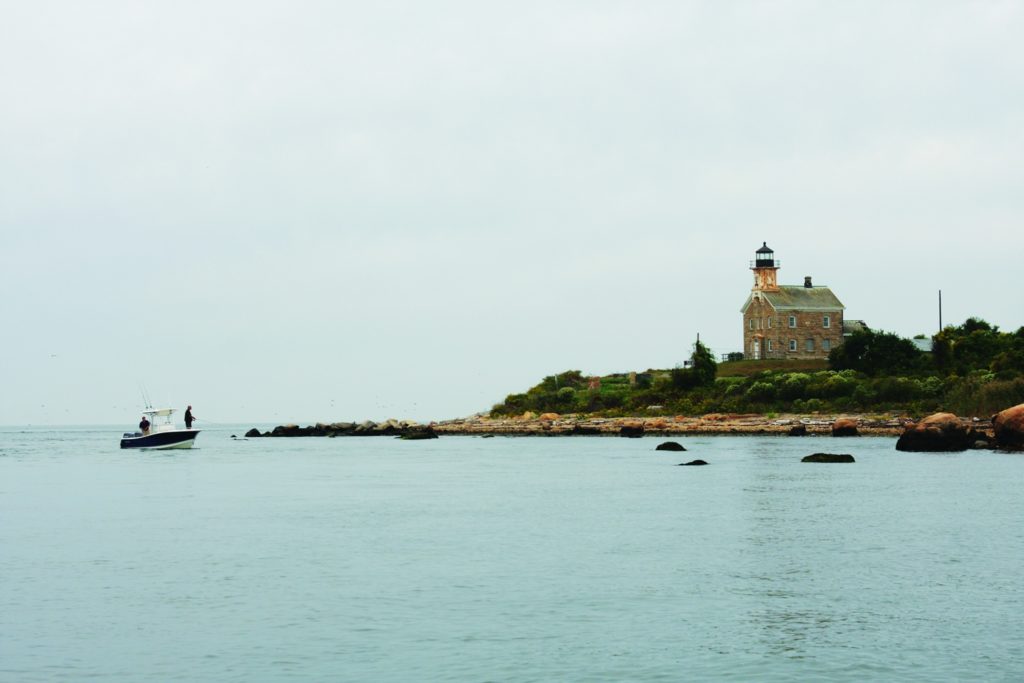
Clichés rushed to mind —“third time’s the charm” and “three strikes, you’re out”—but none ended up applying. A big bluefish had chased, crashed and missed my topwater on three successive attempts. The final hit came just as I lifted the plug from the water. The slammer blue startled and soaked me as it connected with the treble hook and ran, almost yanking the rod from my hand, the spool like a tire spinning in snow.
“I’m on!” I called to Bard. “He smacked it right next to the boat.”
I heard it!” Bard replied, his back to me. “I’ve got one too. I think it’s a bass. It inhaled my lure.”
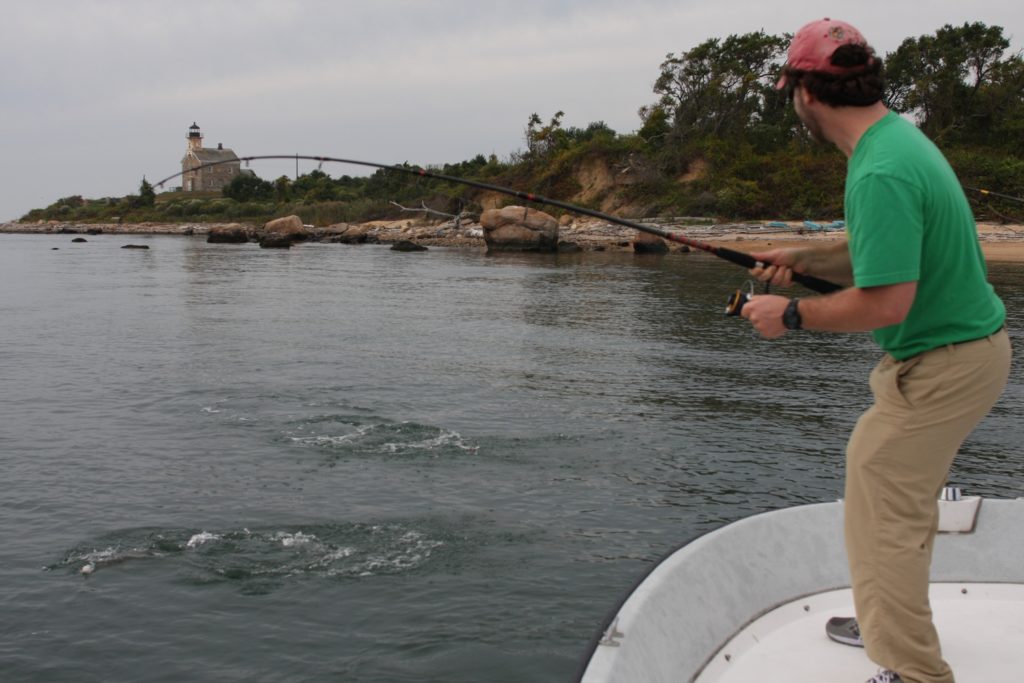
Moments later, Bard and I waltzed around the center console as our lines crossed and then crossed again. I ducked under Bard’s rod as he reached his over me, trying to control the chaos while I kept an eye on a boulder looming down-current. Finally, with one hand still locked on my bent rod, I cranked the engine and nudged it into gear, idling us to safer water and leading the predators out of the rocks like untrained dogs on leashes. It was late September, and shaping up to be a great afternoon along a gnarled island 8 miles off Connecticut.

Birth of World-Class Fishing Structure
About 85,000 years ago, the Late Wisconsin Glacier inched its way southeast from Canada, eventually reaching southern New England approximately 26,000 years ago. As the ice mass moved, a mile high at its thickest, it compressed and scoured the landscape like a massive, creeping bulldozer.
Roughly 6,000 years later, the glacier paused just beyond Connecticut and began to recede. At this point, the huge floe deposited its end moraine — mountains of sediment composed of rocks, gravel, sand and soil — creating most of western Long Island, New York. World-class fishing structure was born.
As the glacier retreated, it paused several more times, depositing additional moraines and forming the east end of New York’s Long Island, Plum Island, Great Gull Island and Fishers Island. The glacier also dropped smaller rubble piles in northern Long Island Sound, including Falkner Island, Charles Island, the Norwalk Islands and the Captain Islands. Farther northeast, moraines also created the now-famous tourist and fishing destinations of Block Island, Rhode Island and the Elizabeth Islands, Martha’s Vineyard, and Nantucket, Massachusetts.
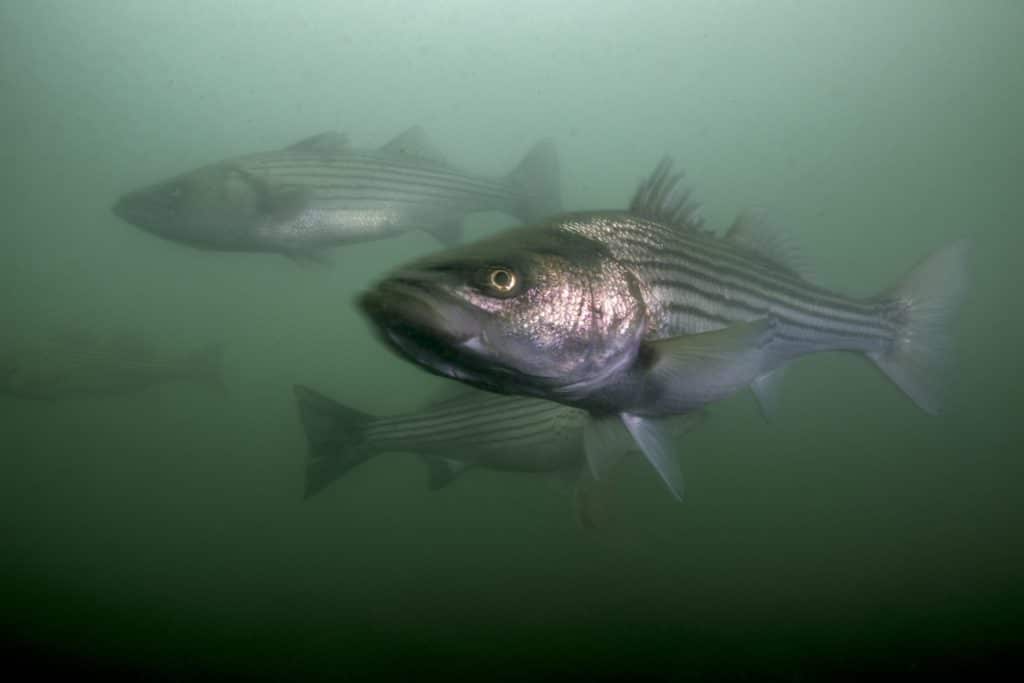
Boulders Attract Predators
Boulders in a tidal current are to bluefish and striped bass what rocks in a stream are to brook and brown trout. These random obstacles disturb water flow and create resting and feeding stations for predators and prey.
“Big rocks provide optimal structure and divert currents,” says Capt. Chris Elser, a shallow-water expert from southwest Connecticut with more than 35 years of experience fishing coastal islands. “The water around boulder fields becomes oxygenated from wave action and currents coursing between and over large rocks, which attracts crustaceans, eels and many other baitfish.”
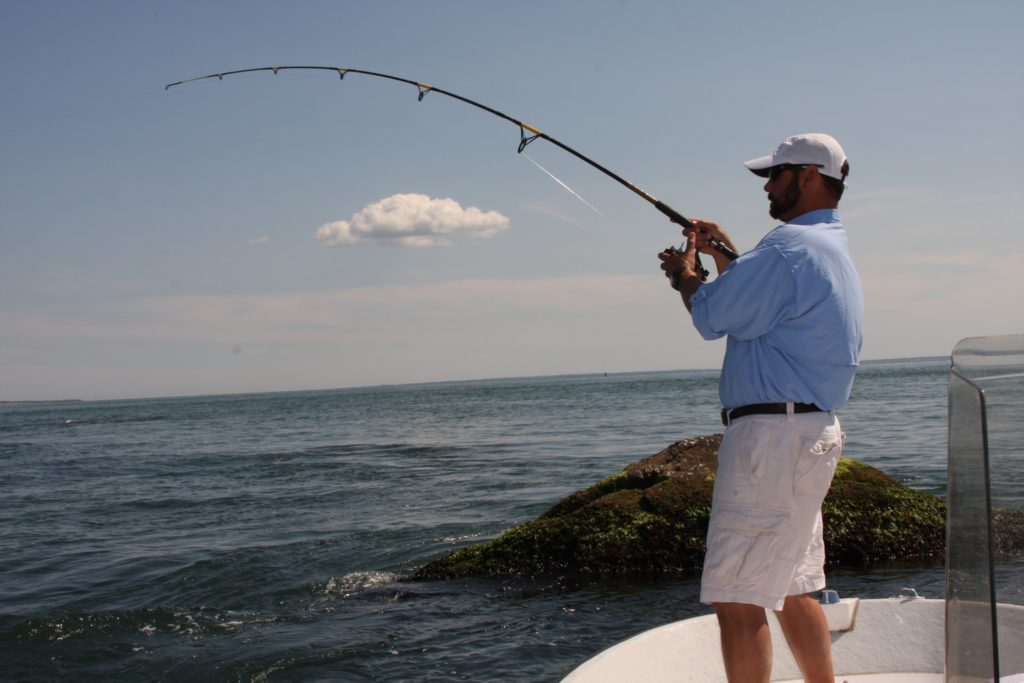
Rocks also draw baits because they host seaweed, which in turn provides forage and sanctuary for prey species. “Stripers and blues stalk these baits by holding near boulders,” says Elser. “They lurk there in ambush mode. The sheltered areas also allow large fish to expend minimal energy in a highly productive feeding environment, and they feel protected in the vast structure.”
The Why and Where of Islands
Islands are worth the time, effort and fuel it takes to fish them because not everybody’s small boat can get there; only skilled and serious anglers make the trip across big bays and sounds, and that means less competition. Islands are more often adjacent to deeper water than is mainland structure, and islands have current flow on all sides, which gives fish and fishermen more options, including shelter. Islands are 360-degree habitats in which fish might feed on either the incoming, outgoing or both tide phases.
When searching for prime casting stretches, pros always study the dry land contours. For example, if the shore is flat and gradual, expect adjacent water to be shallow with a clear bottom. Conversely, if the island banks are steep and rocky, pros expect the bottom to drop off abruptly. The more rugged the structure, the better the chance of finding large fish.
With Structure, Size Does Matter
Upon idling into a promising area, experts work the outer edges of a boulder field first, where the water is deepest, and progressively move and cast closer on each drift. Points, corners and pockets are key target zones because they are near strong currents but also provide eddies where fish station and hunt.
“Dominant fish usually own the territory near the biggest rock,” says Elser, “so it’s key to find the largest piece of structure within a particular group of rocks. I prefer to fish structure on the side facing the wind because it adds to the speed of the upper currents and creates whirlpools in the boulder fields. Small baits struggle here, making for easy prey. The current and wind wash crabs, shrimp, eels and other baitfish into the surf, creating feeding opportunities.”
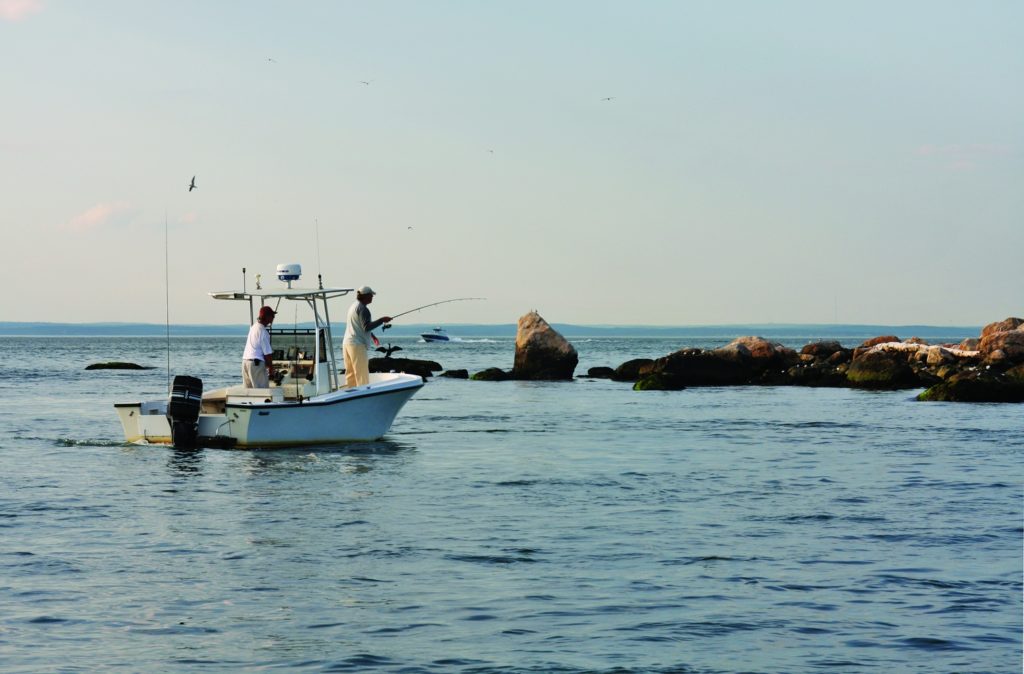
Capt. Ned Kittredge, a pro from southern Massachusetts with 40 years of experience, looks for shallows of 2 to 20 feet over rocky shoreline structure with moving water. “I’ve found stripers in as little as 18 inches of water,” he says. “The action in this range can be phenomenal and breathtaking. But it’s not necessarily fast water. The current I look for is more subtle. On the deep end, if there’s bait present and the fish are feeding, they’ll come up from 20 feet to grab a plug. But not much deeper than that.”
Working the Waters
Stripers and bluefish spook easily when feeding in less than 15 feet of water during calm conditions, so it’s important to cover the water before your boat drifts through. When the current is moving fast, slowing your boat is a good technique that enables you to fan-cast the edges of the boulder field before being pushed past them. You can employ a trolling motor, push-pole or anchor to control your drift.
Kittredge starts a drift in approximately 25 feet of water and slowly works toward shore, casting over as much area as possible until he locates fish. “I’ll sometimes use a drift sock to slow the boat,” he says of those times when there is a breeze opposing the current.
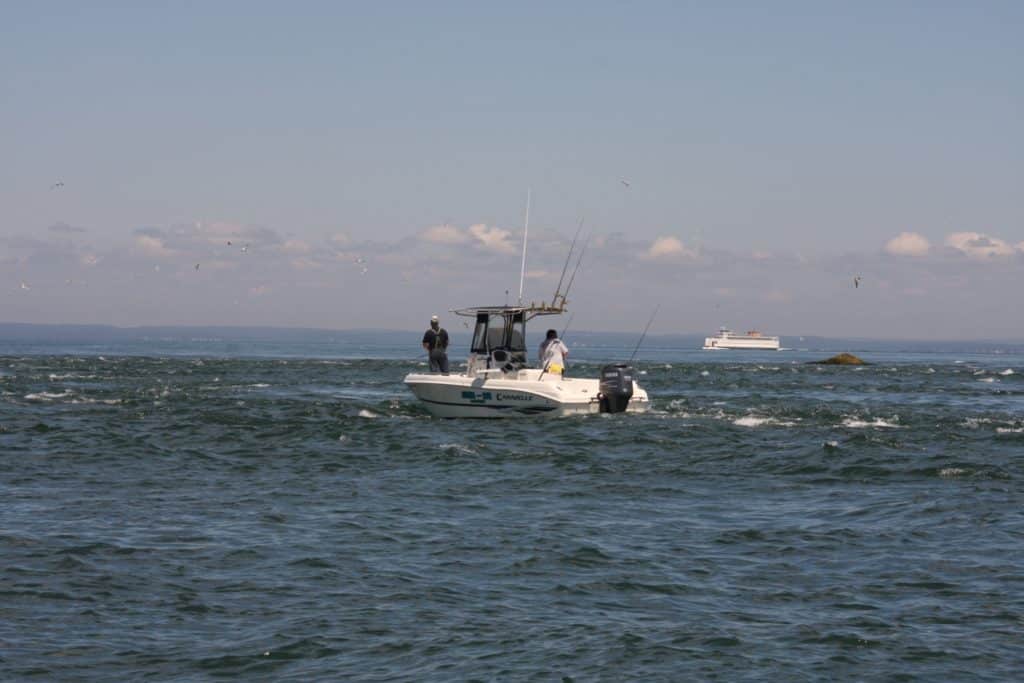
When conditions are right, the most challenging and exciting way to access big fish is to stalk them in skinny water among the boulders. Cutting-edge anglers use their fishing boat as a mothership to transport kayaks or stand-up paddleboards to an island, and then deploy them to paddle over water too shallow for a powerboat.
“On calm days,” says guide Sean Callinan (email scallinan1@gmail.com), who specializes in SUP adventures along the Connecticut coast, “you can’t beat the thrill of casting a plug or fly to predators while gliding through a maze of structure that may hold your trophy.
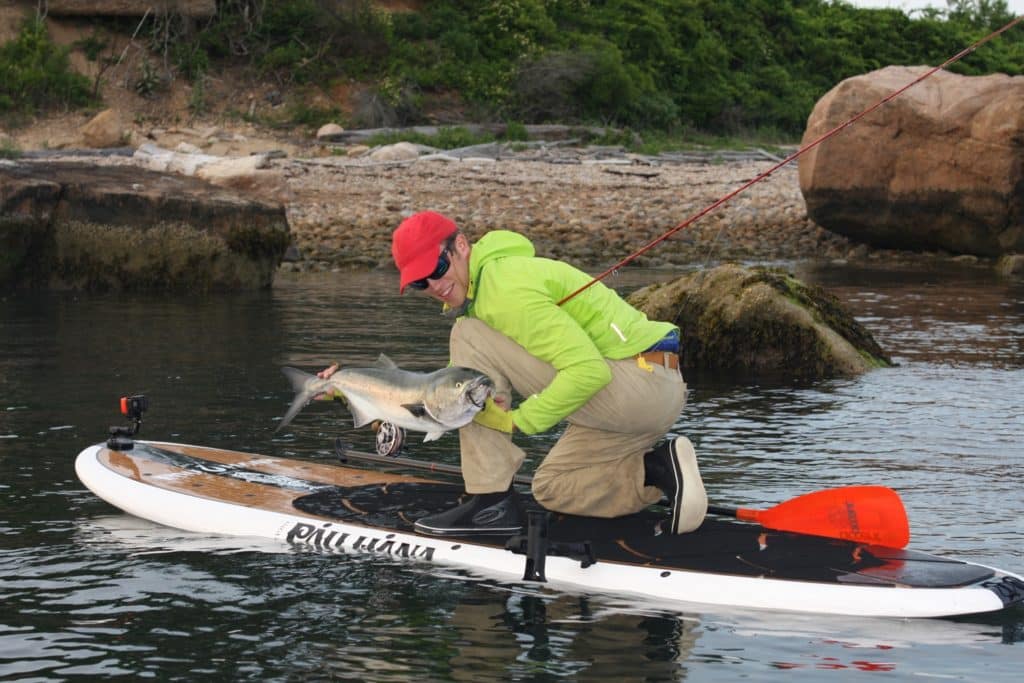
Of course, paddlers must bring all necessary safety gear, including a flotation device, a cellphone in a resealable bag, a bottle of water, a signaling device and a pair of waterproof handheld radios to communicate with the mothership. An experienced companion must man the mothership and fish within sight of the paddler.
Topwater-Fishing Tricks
“First,” says Capt. Dixon Merkt, a light-tackle and fly specialist along the tide-swept islands and rips of eastern Long Island Sound, “you need to learn how to read the water. Look for nervous water created by the current moving over submerged structure. Start fishing ahead of it and work your way down through it. Never hesitate to cast way beyond that nervous water and retrieve the plug back over it so it looks like an escaping baitfish traveling over a distance.”
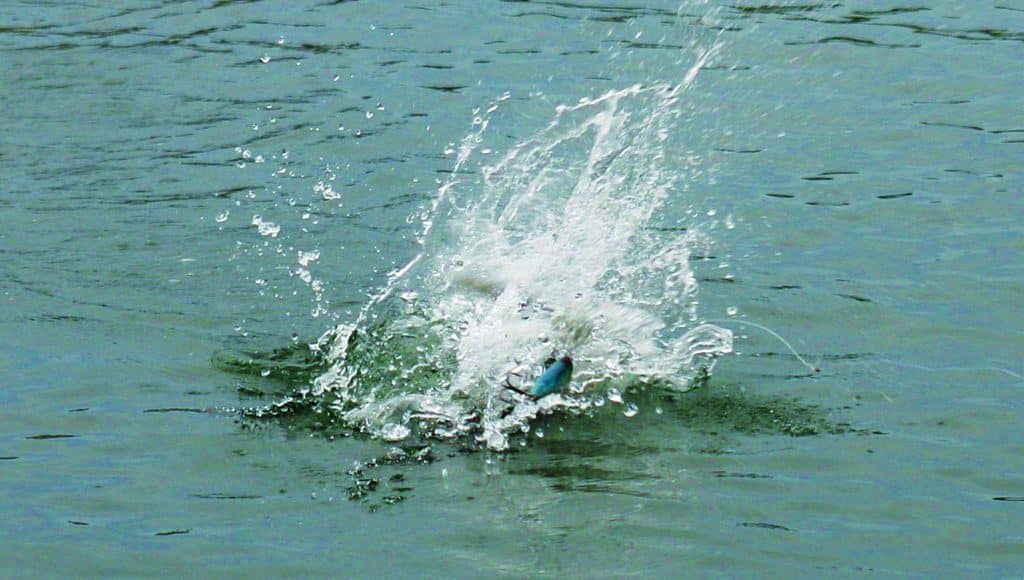
Any retrieve works for blues and bass when they’re aggressive and hungry. But when they’re fussy, you’ll need to vary your technique until you find one that produces. For bluefish, a steady, fast and noisy retrieve is effective. But for stripers, most pros slowly work a spook or pencil popper in a walk-the-dog style. Occasionally changing speed or pausing will often prompt a strike from a stubborn linesider.
“If you get a blue that short-hits and misses the plug several times,” says Merkt, “stop and then start the fast retrieve again. You’re likely to hook up on the next attack.”
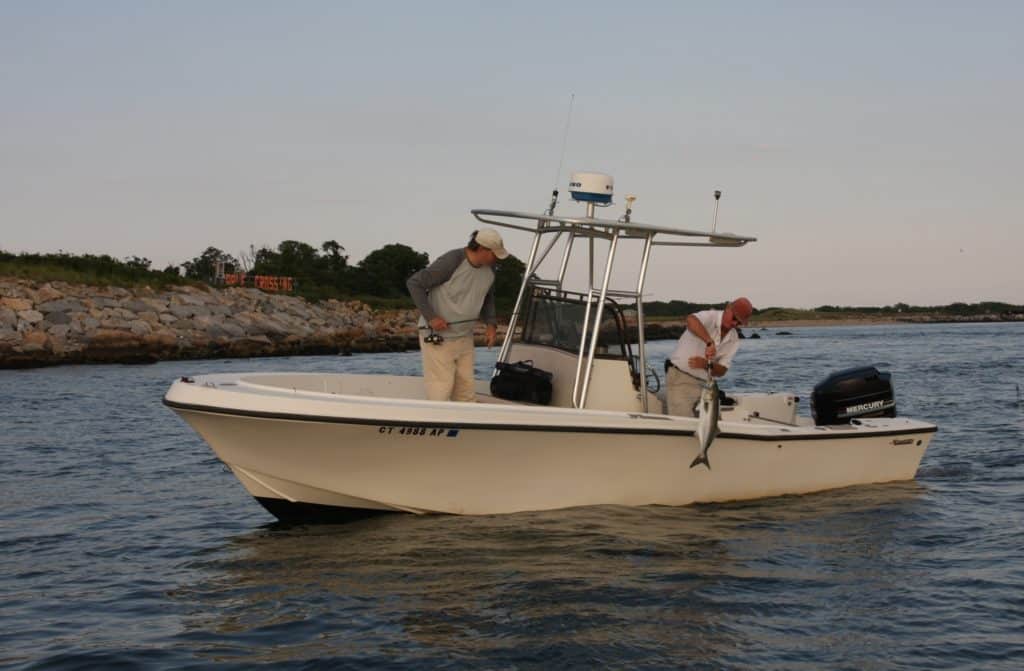
Once a fish grabs your topwater, you’ll need to put some backbone into the set because a slow-moving lure won’t set itself. “Blues and big stripers have a mouth as hard as Tupperware,” says Kittredge, “and you need to punch a hole in it. Once a fish is hooked, use plenty of pressure to work it out of the rocks as quickly as possible, using the motor if necessary, and hope for good luck. I’ve lost plenty of big bass because I wasn’t ready for a fish of that size.”
Best Times to Fish; Best Rigs to Use
“As a rule of thumb,” says Elser, “the lower the light, the shallower the water you can productively target. Ninety percent of my topwater fishing takes place near dawn and dusk.
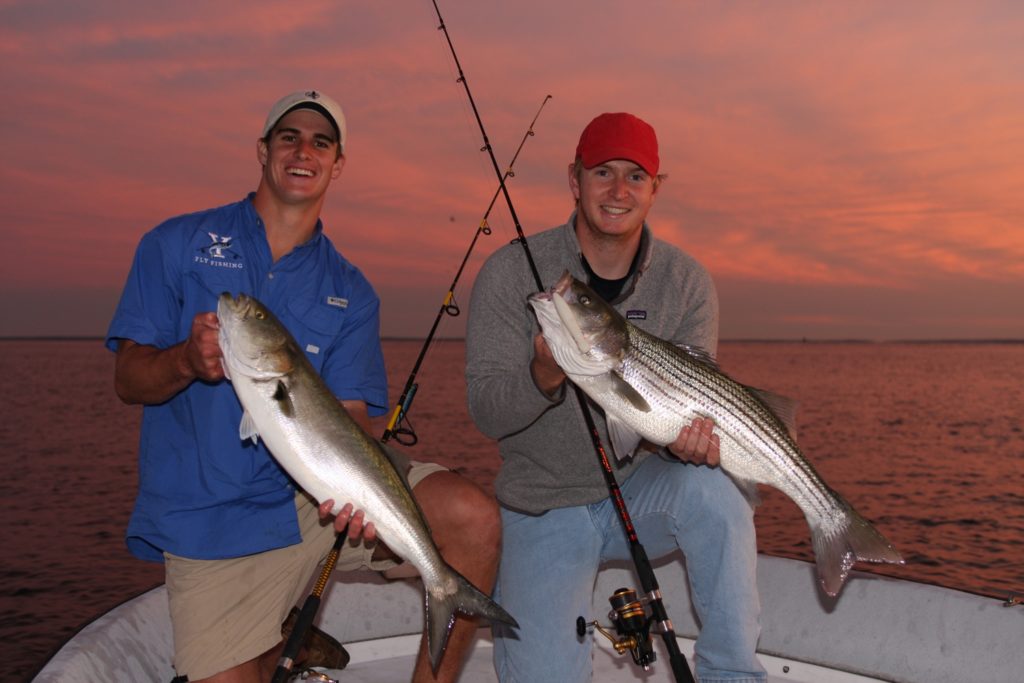
Elser favors a 12- to 20-pound-class 7-foot Lamiglas Tri-Flex rod loaded with 30-pound Daiwa Samurai braided line. He attaches a 3-foot section of 25-pound fluorocarbon leader.
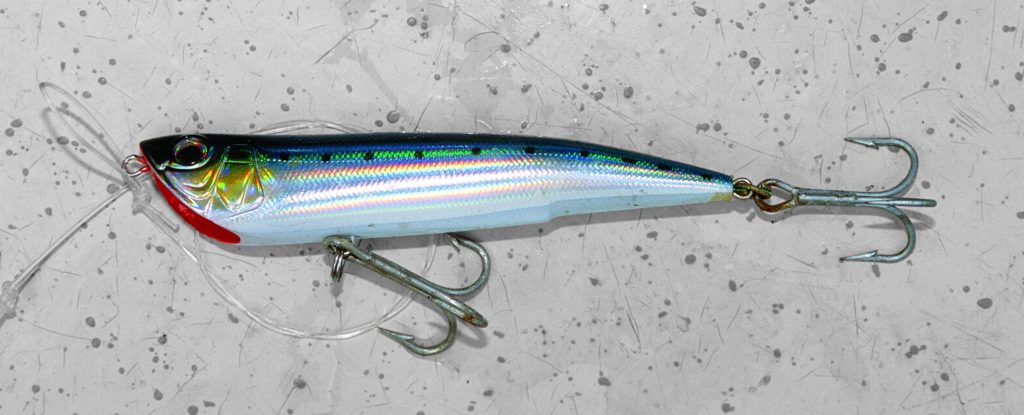
Kittredge slings his big lures with 7- to 8-foot medium spinning rods, like the G. Loomis BR933S. He matches the rod with a Shimano Sustain 5000 spinning reel. He likes 40-pound Spectra braided main line for its abrasion resistance in the boulders and positive hook-sets. To that he attaches a 4- to 6-foot section of 40-pound fluorocarbon leader using a double uni-knot for the line-to-leader connection.
“Eels cost a lot,” says Kittredge, “and they don’t really work properly when fish are against the rocks in the wave wash in only 2 to 3 feet of water. Plugs produce well in skinny water and rarely get hung up. Plus, you can get out fishing in a moment’s notice with minimal preparation. Best of all, it’s extremely exciting seeing a big fish smack a topwater.”
Dave Bard and I finished our September evening with three big bluefish, about a dozen schoolie bass and one 37-inch trophy. As we ran back across the pond in the fading twilight, we traded waves with tourists on a passing ferry, happy that we were in the smaller vessel, returning from a great boulder-field adventure.
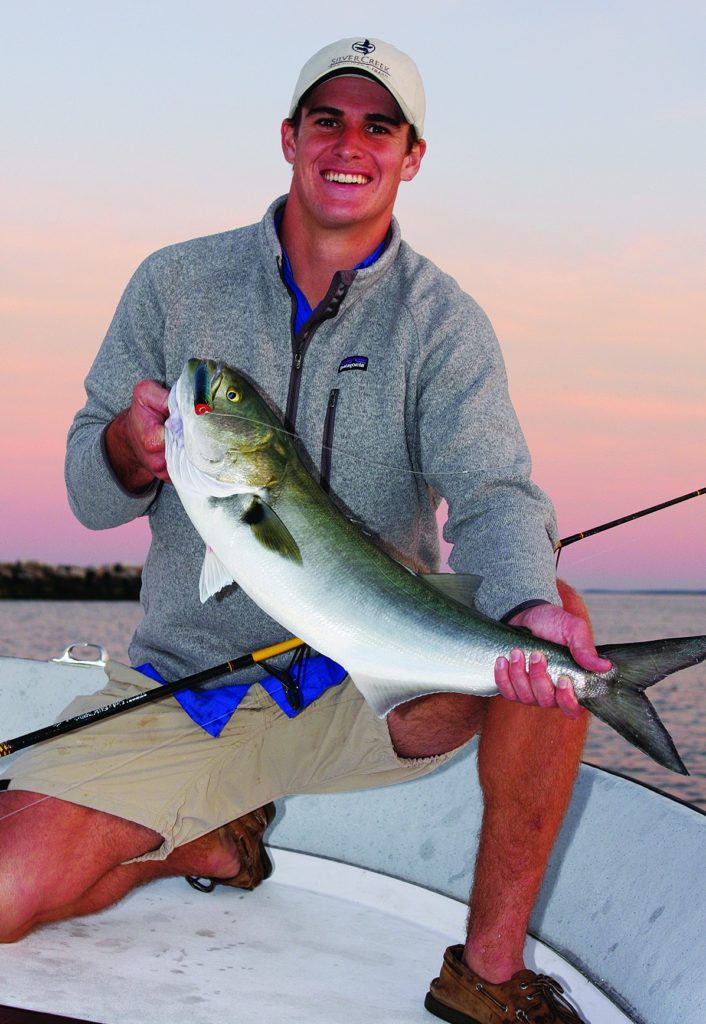
Best Boulder-Field Lures: Experts’ Picks
If you’re expecting bluefish, buy plugs with a single tail hook, or change out the two factory trebles for an in-line single hook at the rear. At the least, for catch-and-release bass fishing in challenging conditions, remove the forward treble hook for both your safety and the fish’s.
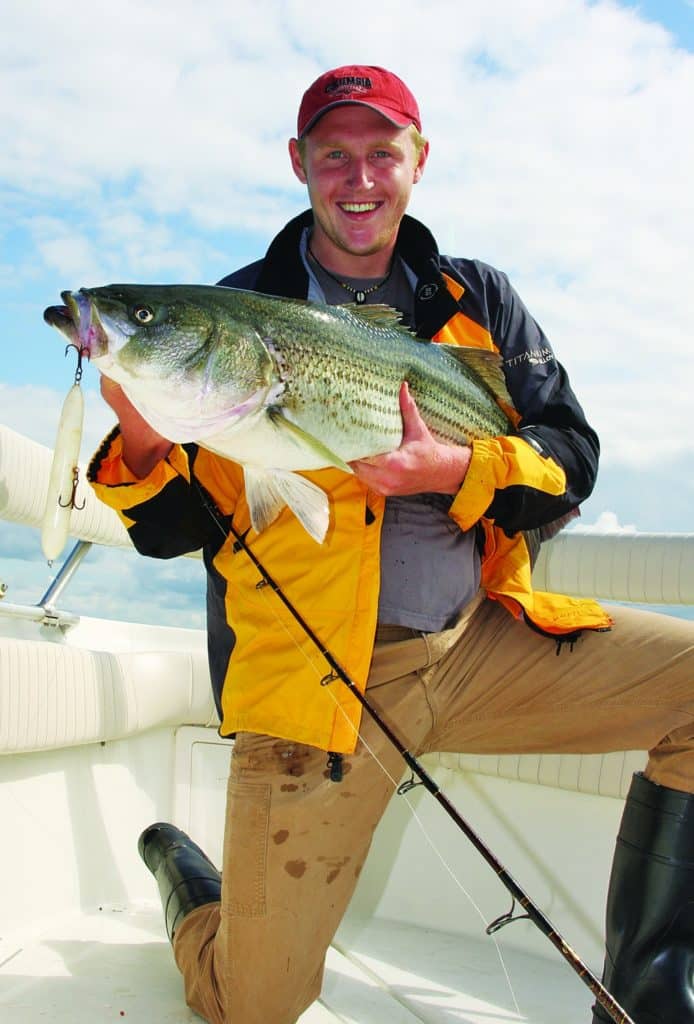
Some lures favored by the pros:
• 1¼-ounce Stillwater Lures Smack-It Popper
• 7/8-ounce Heddon Super Spook
• 9-inch Doc
• 1½-ounce Gibbs Pencil Popper
• 3-ounce Gag’s Grabbers Bluefish Bomb
• 1½-ounce Creek Chub Striper Strike
• 1½-ounce Gibbs Polaris Popper
• 1¼-ounce Atom Swingin’ Swiper Striper
• 1-ounce Yo-Zuri Mag Popper
STAYING SAFE
Casting among island boulders miles from the mainland has its rewards but also its risks. The surf, wind or current can quickly push you into the rocks, causing grounding, hull damage or a busted prop. “The cost of failure is very high,” notes Capt. Merkt. “Twice, with an old engine, I suddenly couldn’t get it started and ended up frantically throwing out an anchor, and both times had the stern swing within feet of a turbulent shore. These aren’t places that inexperienced fishermen should go.”
Tips for safely fishing boulder fields:
• Have an anchor handy and ready.
• Never fish alone.
• Anchor or use a trolling motor when fishing in an onshore wind.
• Pay attention, even when you’re fighting the big one.
• Study your chart, know the depth contours and structure, and set up drifts in the safe zone.
• Use your GPS tracking option to monitor and repeat safe drifts.
• Have someone skilled at the helm.
• Leave the motor running during turbulent conditions.
• Keep your engine tilted as high as possible without sucking air.
• Use a telescopic push pole to fend off rocks.
• Learn the waters and structures at high and low tides.
• Wear polarized sunglasses to help watch for rocks.
• Leave a float plan with someone reliable.
About the Author









